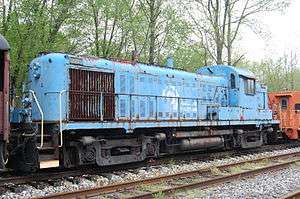RS3m
 | |||||||||
| |||||||||
| |||||||||
| |||||||||
The RS3m is a diesel-electric locomotive rebuilt from an ALCO RS-3 road switcher. There are many variations with various spotting features, the common features being the ALCO RS-3 frame, trucks, and usually cab and short hood. Railroads started rebuilding their RS-3 fleets early on because of the unreliability of the ALCO 244 prime movers.
Perhaps one of the earliest examples of the RS3m is the former Missouri-Kansas-Texas Railroad's RS3m fleet. Built in the early 1950s by ALCO, the Katy had them rebuilt in the late 1950s by ALCO competitor, EMD, who rebuilt them with GP9 long hoods to make room for the larger EMD 567 prime movers.
The Chicago and North Western Railway had a fleet of RS-3ms that were rebuilt using ALCO components. These feature long hoods from ALCO RS-11 road switchers.
Penn Central started rebuilding RS-3s in 1972, using parts from retired EMD passenger engines. The RS3m rebuild program started in 1972 and continued until 1978 under Conrail. The bankrupt Penn Central needed more reliable local and secondary service locomotives and had a surplus of passenger locomotives. The result is a locomotive that has the frame, body and trucks from an ALCO RS3, but using fan assemblies and EMD 567 prime movers from retired passenger engines, such as the EMD E8, in place of the original ALCO 244 prime movers.
The principal visible difference on the Penn Central/Conrail rebuilds is the addition of two conical-shaped EMD switcher style exhaust stacks in place of the one rectangular-shaped ALCO stack and a raised hood. Later rebuilds would just have a raised feature on the long hood to accommodate the larger prime mover. The shape would vary from a rectangular shape with fillets on the long sides to a simple box on top of the long hood. These locomotives are often called DeWitt Geeps, so named because Penn Central started rebuilding them in their DeWitt, shops in Syracuse, New York.
In 1975 The Green Bay and Western Railroad started rebuilding their four RS-3 units. They lowered the nose and raised the long hood for their new Alco engines. These rebuilds are called RS-20s.
RS3u
The Delaware and Hudson Railway had eight RS3u locomotives which are often mistakenly called RS3ms. These locomotives were rebuilt by Morrison-Knudsen of Boise, ID (also known as M-K TE56s) between December 1975 and March 1976. They received ALCO 12-251C prime movers, boosting horsepower from 1,600 to 2,000 hp (1,200 to 1,500 kW). To facilitate the larger prime mover, M-K raised the long hood six inches (152 mm) and moved the dynamic brake cooling to a box behind the cab. The units also received a cut-down short hood for greater visibility. The D&H was not overly fond of the conversions, referring to them as "Club Foots", because of their tendency to slip under heavy loads. It was thought that the 2000 hp prime mover was too powerful for the lightweight carbody. Today, D&H #506 survives at the Western New York & Pennsylvania Railroad as number 406.
GP12 and GP16
The Missouri Pacific Railroad had a fleet of RS-3s that were rebuilt, receiving the GP12 or GP16 designation after rebuilding. These look like normal ALCo RS-3s with the addition of more exhaust stacks.
RS3ms today
As of 2012, rebuilt RS-3s can be found in museums, on shortlines and as industrial switchers. The Rochester & Genesee Valley Railroad Museum has an operating RS3M painted as Lehigh Valley 211. Another example can be found on the Midland Railway MKT #142 in Baldwin City, Kansas. The Cape May Seashore Lines also owns a former Conrail RS3M which is still painted in its faded former Conrail livery. Pioneer Railcorp has an RS3m stored on their property which was formerly used on the Michigan Southern Railroad The Maryland and Delaware Railroad owns three former Conrail units, numbered 1201, 1202, and 1203.
Sources
- Penn Central Historical Society
- Bridge Line Historical Society
- Midland Railway Historical Association
- rrpicturearchives.net